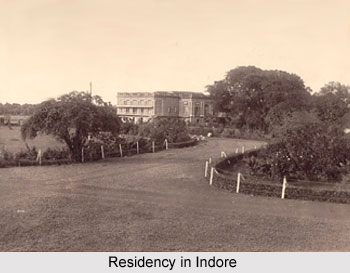 The Indore Residency was one of the residencies or political offices of British Empire in India, which also included the Baroda Residency, the Mewar Residency, the Gwalior Residency and the Persian Gulf Residency. The Residencies of British India were mainly political offices, which dealt with the relations between a large number of princely states and the British dominated India. The Indore Residency, like other Residencies of British India, was developed as a system of indirect rule which was vigilantly managed and administered by a Resident of British India. The Indore Residency incorporated most of the princely state of Indore. After the year 1933, the princely state of Rewa also became a part of the Indore Residency, which was earlier included in the Bagelkhand Agency, which as a collection of Indian princely states during the British rule. Rewa was the second largest princely state in Central India Agency and the largest in the Bagelkhand Agency.
The Indore Residency was one of the residencies or political offices of British Empire in India, which also included the Baroda Residency, the Mewar Residency, the Gwalior Residency and the Persian Gulf Residency. The Residencies of British India were mainly political offices, which dealt with the relations between a large number of princely states and the British dominated India. The Indore Residency, like other Residencies of British India, was developed as a system of indirect rule which was vigilantly managed and administered by a Resident of British India. The Indore Residency incorporated most of the princely state of Indore. After the year 1933, the princely state of Rewa also became a part of the Indore Residency, which was earlier included in the Bagelkhand Agency, which as a collection of Indian princely states during the British rule. Rewa was the second largest princely state in Central India Agency and the largest in the Bagelkhand Agency.
The Indore Residency was part of Central India Agency, which was a political office of the British Indian Empire. The Central India Agency was formed up entirely of Indian princely states that were under the administration of native rulers. The Central India Agency was established in the year 1854, by combining various minor political offices that previously reported to the Governor General of India. The princely state of Indore, also known as Indaur, was ruled by the Holkar dynasty and the state was considered as one of the Salute States of India and was given a 19 guns salute. The Maharaja of Indore state formed a subsidiary alliance and accepted British suzerainty of the external affairs of the princely state. The native ruler was allowed to retain internal autonomy and control and was under the indirect rule of the British government of India.
After India attained independence in 1947, the Indore state was acceded to the newly created Union of India and Indore was incorporated as a district of Madhya Bharat state. Later it was merged with the present state of Madhya Pradesh in the year 1956. The princely state of Rewa was also acceded into the Indian Union and was merged with the Vindhya Pradesh that was created by the amalgamation of the erstwhile Indian princely states of the Bagelkhand, as well as Bundelkhand agencies.



















